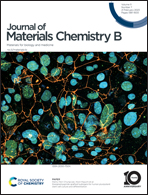Revealing the antibacterial power of hydrogen-releasing PdH nanohydride against drug resistant Staphylococcus aureus: an in-depth mechanism study†
Abstract
Currently, multidrug resistant (MDR) bacterial infections are a great threat to public health, and the development of novel strategies for high efficiency combatting of MDR bacteria is in urgent demand. Hydrogen (H2) is a small gas with a high reducing ability, and plenty of recent studies have demonstrated its therapeutic effect on many diseases. However, the antibacterial effectiveness and mechanism of H2 against MDR bacteria are still unknown. In the present work, using PdH nanohydride with a temperature responsive H2-releasing property as the H2 source, we demonstrated that H2 was not only able to inhibit the growth of normal Staphylococcus aureus (S. aureus), but could also effectively eliminate single drug resistant S. aureus (CRSA) and multidrug resistant S. aureus (MRSA), as well as the biofilms formed by those bacteria. Moreover, an in-depth mechanism regarding the anti-antibiotic-resistance activity of H2 was elucidated by us, in which H2 exerted its antibacterial effect by firstly causing severe membrane damage, followed by boosting generation of intracellular ROS, which subsequently triggered DNA damage and finally led to bacterial death. The proposed mechanism was further verified by genomic analysis, where a cluster of genes related to bacterial membrane integrity, biofilm formation, metabolism and DNA functions was significantly perturbed by the released H2. In particular, H2 boosted intracellular ROS generation by destroying the redox homeostasis of bacterial metabolism. More importantly, we revealed that H2 was able to alleviate the antibiotic resistance of CRSA and MRSA by significantly down-regulating the expression of many drug-resistant genes, e.g. the norG gene of CRSA, and fmtA, gpsB, sarA and marR genes of MRSA, as well as reducing the minimal inhibitory concentration (MIC) of ciprofloxacin/ampicillin against CRSA/MRSA. The findings in our work suggested that H2 therapy is a promising tool for combating antibiotic-resistant bacteria.



 Please wait while we load your content...
Please wait while we load your content...